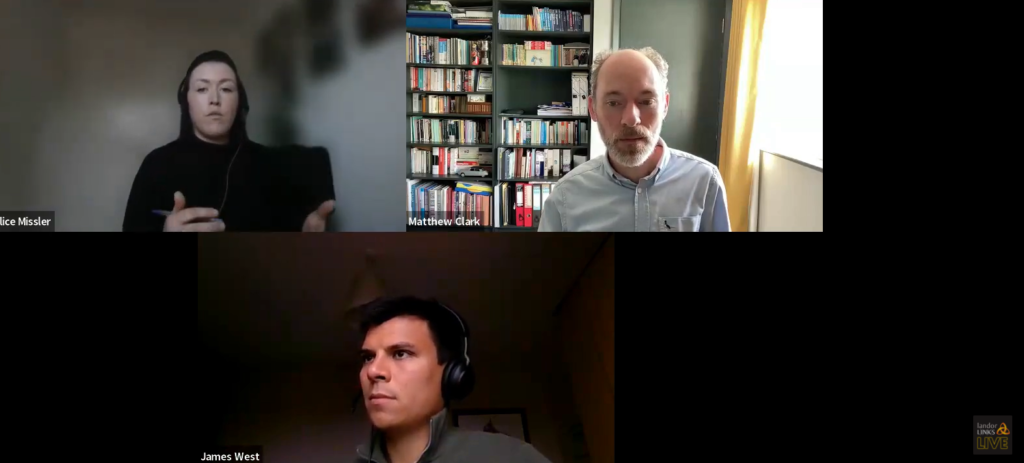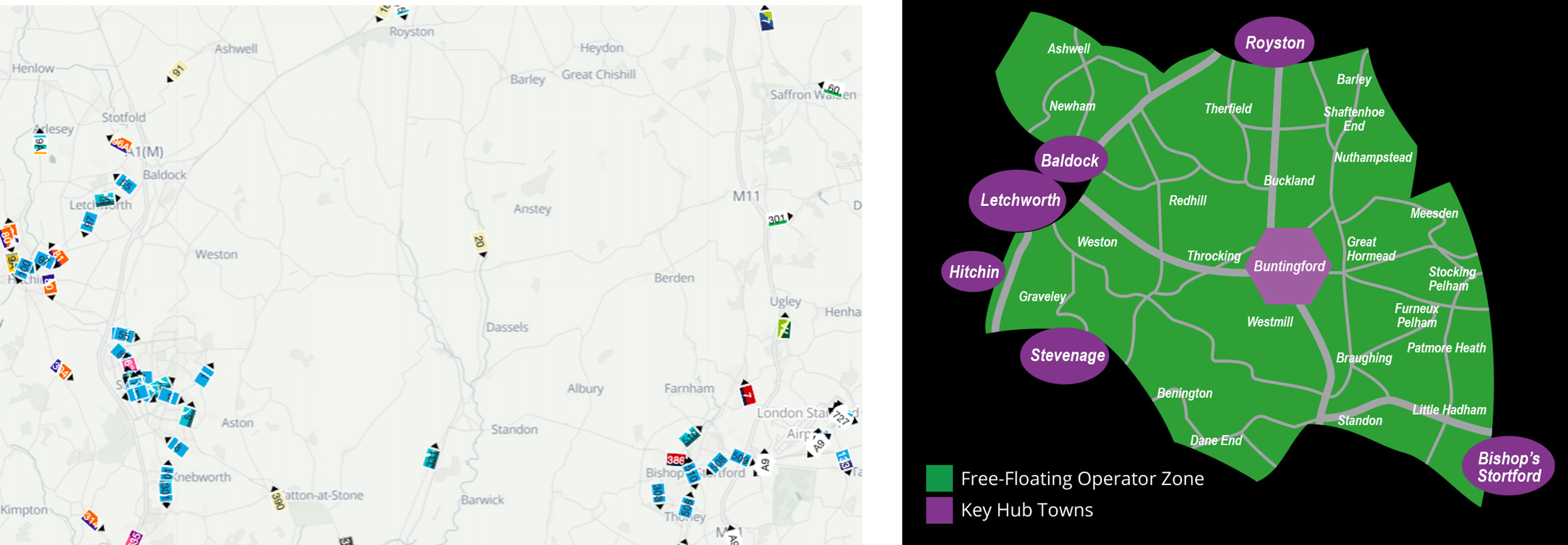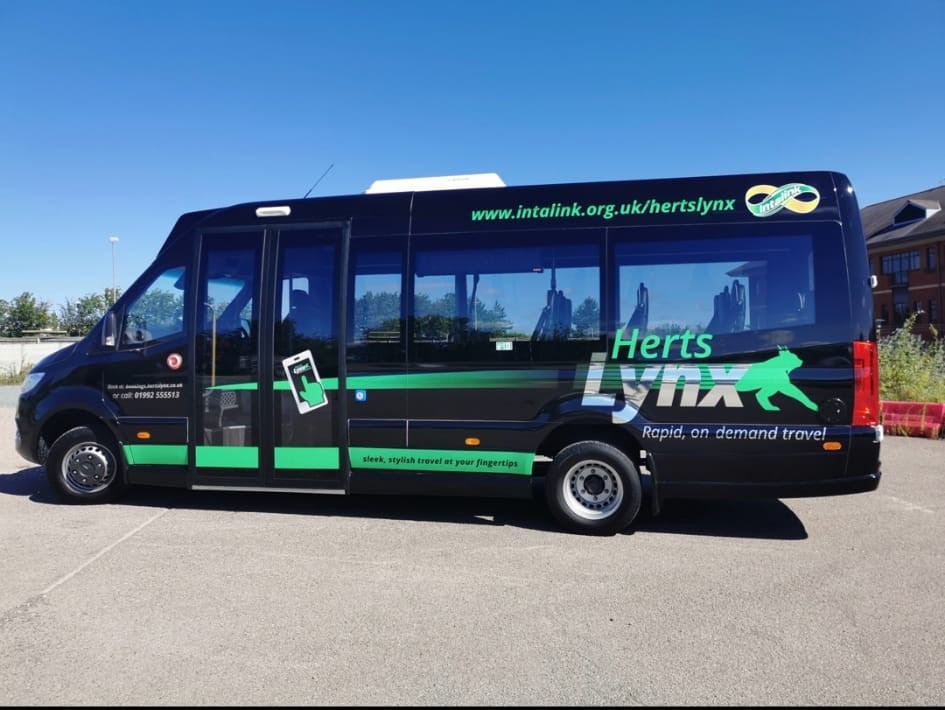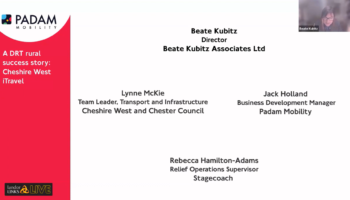Hertfordshire County Council has been providing the HertsLynx on-demand service since 2021. The service was the first Demand-Responsive Transport (DRT) to be funded by the Rural Mobility Fund, with the council receiving a total of £1.4 million in funding from the UK Department for Transport in spring 2021.
The DRT, developed by Padam Mobility, was designed to improve the mobility challenges of the rural area. In north east Hertfordshire, public transport services were infrequent and sparse. A total of 10 neighbourhoods, with a population of around 4,000 people, had no access to a public bus at all, with the deprivation that entails. These people relied on a private car to get to work, go shopping or attend leisure activities, and if they did not have access to one, relied on family, friends and neighbours for all their transport needs.
The newly introduced HertsLynx service was implemented in areas where commercial services do not operate for economic reasons. The 400 km² service area covers six Key Town Hubs connected to the rural areas. Rather than following a fixed route, the on-demand service transports users in a free-floating configuration along the fastest route to their destination. All existing bookings are processed by an algorithm and calculated in such a way that as many passengers as possible are grouped together in the same vehicle.
Rapid uptake of the Hertfordshire County Council HertsLynx on-demand service and its digitised Dial-a-Ride service demonstrates the impact that accessible public transport can have on the quality of life of people in rural areas.
In a recent webinar, hosted in partnership with Landor Links, Alice Missler, DRT/Community Transport Team Leader at HCC, and James West, UK Business Development Manager at Padam Mobility, talked about what sets the HertsLynx service part and what makes it successful. There was great interest in the webinar and the limited time available made it almost impossible to answer all the participants’ questions. The following Q&A answers some of the most frequently asked questions. We are of course also available for a personal discussion if you are interested in our services. Please contact Jack Holland (jack@padam.io) or James West (james@padam.io).
Q&A from the Padam Mobility Webinar, 10 May 2023, presented by Landor Links and hosted by Matthew Clark, Steer:

The HertsLynx DDRT service
- Can the current HertsLynx fare allow the service to operate commercially rather than having to be funded?
- Ticket revenue alone is currently not sufficient to make the HertsLynx service economically viable. The ultimate goal is to reach people without access to a functioning public transport service. The HertsLynx service will continue to rely on funding in the future, but efforts are already underway to make the service more efficient by, for example, combining the DRT with school trips and other use cases.
- How have you promoted the service (to different target groups)?
- By increasing accessibility and creating awareness. For example, the service hours were extended at weekends. The HertsLynx evening service runs on Friday and Saturday from 20:00 to 23:30 in the regular HertsLynx area and gives young people, in particular, more freedom in their leisure activities.
- Is there still an impact of the pandemic on user numbers?
- The HertsLynx service was launched at the height of the covid19 pandemic, which was reflected in the user numbers at launch. Today, the impact post-pandemic on passenger numbers is hardly noticeable. Passenger numbers have increased significantly since the service was introduced.
- Has the £2 cap attracted new bus users or only helped existing ones?
- We have seen a slight increase in ridership, although this cannot necessarily be traced back to the £2 cap. However, making public transport affordable for all is certainly important and impacts how people perceive public transport.
- How can users pay for a ticket?
- HertsLynx is a cashless service. When registering in the app, users need to provide their debit/credit card details so that rides can be charged to that card. There is also the option to buy credits.
- How will users be warned if there is a problem with the vehicle (e.g. a breakdown) and the trip cannot be carried out?
- We can display current messages both on our website or via the app and inform users about timetable changes on time. We recommend allowing push notifications to receive the latest news directly.
- How can older people who don’t have a smartphone book a ride with the service?
- There are several ways to book a trip with the HertsLynx service. Users who do not want to book via the app can alternatively book a journey via phone or website.
- Is there data (e.g. origin and destination) to show whether services are successfully targeting people with limited access to transport?
- Yes, we collect movement data that shows at which stops in the service area users get on and off. As the service area was set up to provide non-served or underserved places with a reliable public transport service, we can assess where the service is successfully fulfilling this task. This data analysis is very important to guarantee that the service is deployed in a way that meets the HCC’s objective.

Area before the introduction of the DDRT and graphic of the HertsLynx service area: It can be clearly seen that the service area serves the previously free area (no public transport stops).
- Yes, we collect movement data that shows at which stops in the service area users get on and off. As the service area was set up to provide non-served or underserved places with a reliable public transport service, we can assess where the service is successfully fulfilling this task. This data analysis is very important to guarantee that the service is deployed in a way that meets the HCC’s objective.
DRT provided by Padam Mobility
- How does the interchange between DRT services and bus, coach or rail services work?
- The existing public transport network is of great importance when setting up a DRT service. It is possible, for example, to integrate the regional train timetable into the on-demand platform and create services that are subject to certain time constraints.
- Who receives the data generated by the service?
- Padam Mobility’s customers get all the data collected about a service and have sovereignty over the use of the data.
- What is the difference in booking when offering a service from “point to point” rather than “door to door”?
- In the case of a door-to-door booking, users can specify their home as a pick-up or drop-off point and be transported from there to a desired point. This configuration is particularly used for paratransit trips to facilitate access to mobility for users with reduced mobility. When booking stop-to-stop or point-to-point, users choose fixed or virtual stops in their proximity from where they want to start or end their trip. Virtual stops are usually set up close together so that users have short walks. They are not physically visible or are usually marked with a small sign or similar. Services running between virtual stops are usually faster as they deviate less from their routes to pick up passengers.
- How high are the staffing requirements for DRT services compared to scheduled bus services? Considering the shortage of qualified bus drivers, higher staffing requirements could be an obstacle to the introduction of a DRT system.
- DRT services reduce driver requirements and improve recruitment. DRT services often have a smaller fleet of vehicles than fixed-route buses so fewer drivers are needed to cover the area. In addition, DRT fleets consist of minibuses with about 6 to 16 seats. With the common driving licence class B, it is possible to operate a minibus with up to eight seats.



